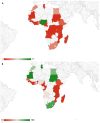Dermoscopy Use in Africa: Determinants and Challenges
- PMID: 38810048
- PMCID: PMC11136078
- DOI: 10.5826/dpc.1402a98
Dermoscopy Use in Africa: Determinants and Challenges
Abstract
Introduction: Dermoscopy has evolved over the years beyond distinguishing benign pigmented lesions from melanoma to diagnosing virtually all diseases in dermatology. Overwhelming evidence demonstrates its utility in improving diagnostic accuracy, reducing unnecessary biopsies and lesion monitoring. Dermoscopy is widely used in Western nations, hence most descriptions of lesions in literature are predominantly on Fitzpatrick skin types I-III. Current evidence shows that there are unique dermoscopic features in the dark skin as a result of pigment and pathological reactions. Nationwide surveys and reports have been conducted across several continents to highlight prevalence and factors influencing dermoscopy use with the hope of maximizing its apparent benefits. There are currently no such reports from Africa.
Objectives: To evaluate dermoscopy use and its determinants among dermatologists in Africa.
Methods: A cross-sectional study. Online forms were e-mailed to individual practicing dermatologists and members of the African Society of Dermatologists and Venereologists.
Results: There were 196 respondents from 24 African countries. Half of them used dermoscopy. Training, practice settings and location, provision of dermatoscopes by institutions and knowledge of criteria were notable significant determinants. Multiple training exposures, knowledge of criteria, availability of dermatoscopes, use of both hand-held and videodermatoscopes, average number of patients seen per day, and a positive outlook towards dermoscopy were significant determinants of frequency of use. Leading impediments were lack of training and inadequate dermatoscopes in practice.
Conclusions: Dermoscopy use in Africa is relatively low. Incorporating dermoscopy training into the curriculum with provision of dermatoscopes by training institutions will promote wider usage.
Conflict of interest statement
Figures
Similar articles
-
A dermoscopy survey to assess who is using it and why it is or is not being used.Int J Dermatol. 2009 Sep;48(9):951-2. doi: 10.1111/j.1365-4632.2009.04095.x. Int J Dermatol. 2009. PMID: 19702978
-
Training Family Medicine Residents in Dermoscopy Using an e-Learning Course: Pilot Interventional Study.JMIR Form Res. 2024 May 13;8:e56005. doi: 10.2196/56005. JMIR Form Res. 2024. PMID: 38739910 Free PMC article.
-
The daily use of dermoscopy in the Netherlands.Eur J Dermatol. 2022 Nov 1;32(6):736-742. doi: 10.1684/ejd.2022.4377. Eur J Dermatol. 2022. PMID: 36856393 English.
-
Role of In Vivo Reflectance Confocal Microscopy in the Analysis of Melanocytic Lesions.Acta Dermatovenerol Croat. 2018 Apr;26(1):64-67. Acta Dermatovenerol Croat. 2018. PMID: 29782304 Review.
-
Dermoscopy for melanoma detection in family practice.Can Fam Physician. 2012 Jul;58(7):740-5, e372-8. Can Fam Physician. 2012. PMID: 22859635 Free PMC article. Review.
Cited by
-
Exploring Pediatric Dermatology in Skin of Color: Focus on Dermoscopy.Life (Basel). 2024 Dec 4;14(12):1604. doi: 10.3390/life14121604. Life (Basel). 2024. PMID: 39768312 Free PMC article. Review.
-
Assessing the Accuracy of Dermoscopy for Scabies Diagnosis in Dark African Skin.Dermatol Pract Concept. 2025 Jan 30;15(1):4848. doi: 10.5826/dpc.1501a4848. Dermatol Pract Concept. 2025. PMID: 40117604 Free PMC article.
References
-
- Errichetti E, Stinco G. The practical usefulness of dermoscopy in general dermatology. G Ital Dermatol Venereol. 2015;150(5):533–546. - PubMed
LinkOut - more resources
Full Text Sources




